Fibre in layer-diets: the importance of choosing the right fibre source
Published: April 16, 2021
By: Manfred Pietsch / J. Rettenmaier & Sohne, Germany, www.jrs.de.
In the past, nutritionists did not pay attention to fibre in poultry feed formulations. Step by step the researcher as well as the industry in this decade has realised the importance of fibre in a poultry feeding strategy. The use of fibre in poultry has been, and still is, a major research topic at universities around the globe.
Professor Mateos group from Spain as well as Prof. Svihus from Norway did a lot of research to explore the effect of different fibre sources on poultry health and performance.
Mateo et al. (2012) summarise the importance of fibre in their review article: “Moderate amounts of fibre might improve the development of organs, enzyme production, and nutrient digestibility in poultry. Some of these effects are a consequence of better gizzard function, with an increase in gastro duodenal refluxes that facilitate the contact between nutrients and digestive enzymes. These effects often result in improved growth and animal health, but the potential benefits depend to a great extent on the physicochemical characteristics of the fibre source”.
Meanwhile it is well established that especially the insoluble fibre has a positive impact on health and performance, while soluble fibre impacts health and performance of poultry negatively.
The main players like integrations, researchers and genetic companies actually promote the use of fibres in layers. ISA and Lohmann consider crude fibre an essential component in layer formulations.
ISA, for example, stated in their feeding guidelines in 2007: “the presence of insoluble fibre appears indispensable, causing an increase in gizzard size, improved starch digestibility and limiting feather pecking”. This article will focus mainly on the impact of insoluble fibre for an improvement of performance in layers.
Fibre classification
Dietary fibre has been described as the skeletal remains of plant cells in diets that are not digested by the animals’ digestive enzymes. A main distinctive feature amongst different fibre sources is the solubility.
Vegetable roots and fruits like apple, orange and sugar beet deliver mainly soluble fibre (i.e. pectin) while all kinds of cereal brans deliver a high percentage of insoluble (i.e. cellulosic) fibre.
Advantages and disadvantages of soluble and insoluble fibre sources are shown in Table 1.
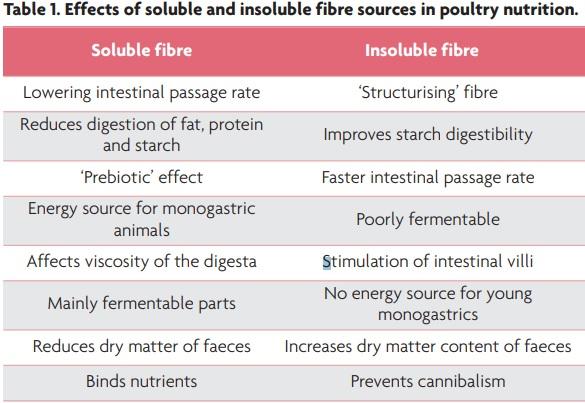

Crude fibre concentrates
Our traditional fibre sources like wheat bran deliver soluble and insoluble fibres. Other traditional fibre sources like oat hulls are quite high in insoluble fibres but unfortunately they are not available on many markets and they are often highly contaminated with mycotoxins. A solution for this problem could be an insoluble crude fibre concentrate (CFC). These functional fibres are constantly available and free of mycotoxins.
CFC describes fibre-products with a crude fibre content of at least 60%. This high content is mostly achieved by concentration processes, which can be of physical or thermo-mechanical nature. CFCs are usually based on a lignocellulosic or a cellulosic fibre. Typical composition of the fibre fraction from fibre sources are shown in Table 2.
Fibre solubility and fermentability
The fermentability of a fibre is strongly related to the environment. For this reason, it is clear that it is necessary to discuss them in conjunction with each other. To give an example: insoluble fibre is fermented to a different extent in the rumen compared to the GI tract of any poultry species. In 1995 Sundvol et al. from the University of Illinois did an interesting trial to evaluate the relation between solubility and fermentability in vitro and in different species.
They used selected fibrous substrates and incubated them for 6, 12, 24 and 48 hours with ruminal fluids from cattle or faeces from dog, cat, pig, horse or humans.
The production of short chain fatty acids (SCFA) has been measured to evaluate the extent of the fermentation. The fibrous materials had a different level of insoluble fibre and total dietary fibre (TDF). This is shown in Table 3.
When data were pooled across species, substrate OM disappearance and SCFA production ranked from least to greatest in the following order: cellulose<beet pulp<citrus pulp<citrus pectin. With increasing level of insoluble fibre there was a reduced level of fermentation.
Better performance results
In many farm and university trials a positive impact of insoluble fibre on performance has been observed. Yuwares Ruangpanit from the Kasetsart University in Thailand (2011) evaluated the effects of the insoluble crude fibre concentrate Arbocel on the hen day egg production in H & N Brown Nick layers from 19-34 weeks of age.

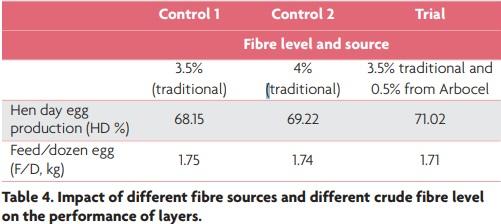
They fed the animals with three different formulations. 3.5% crude fibre from traditional sources, 4.0% crude fibre from traditional sources and 4.0% including 0.5% crude fibre from the insoluble crude fibre concentrate Arbocel. The results are shown in Table 4.
The animals that received 4.0% crude fibre in the formulation including 0.5% crude fibre from the insoluble crude fibre concentrate Arbocel showed almost 2.0% increased hen day egg production (average production in the first 16 weeks) compared to the animals that received the 4.0% crude fibre only from traditional fibre sources.
This demonstrates that the nature of the fibre has a major impact on performance. These results have been confirmed in an on farm trial at the Tynoong North Farm in Australia.
The insoluble crude fibre concentrate Arbocel was used during the whole laying stage on 25,000 birds. The performance of these birds in terms of egg production improved by 2.1% compared to the 25,000 control birds.
A quite interesting observation was done by the Brazilian Federal University of Mato Grosso-UFMT in 2018.
They did a dose response trial whereby they used 0, 0.2, 0.4, 0.6, 0.8 and 1 % of a commercially available CFC instead of corn. The trial was done from week 24 to week 40 with 624 layers (Hy-Line White W-36). The feed formulation is shown in Table 5.
The researchers confirmed the positive effect of insoluble crude fibre concentrate on the performance and additionally they could observe a significant reduction of feed intake due to the use of the CFC. This led as well to an improved FCR. The egg mass was not affected (results are shown in Table 6).
In terms of return on investment an inclusion rate of 4kg CFC/tons of feed was the most efficient. Based on the Brazilian egg and feed prices in 2018 the authors calculated and additional profit of €430,000 per one million layers.
Impact on performance
Insoluble fibres have a positive impact on digestion which is most probably the reason for the better performance. What is the mode of action behind this positive impact on digestion?
Svihus and Denstadli (2010) summarise in their review article that insoluble fibre will prolong the retention time of the digesta in the gizzard which may improve the efficacy of exogenous enzymes.
Due to the prolonged retention time there is more time for enzyme–substrate interaction. The same should be valid if we have a closer look at protein digestion. The first major step of protein digestion is the acid hydrolysis in the gizzard.
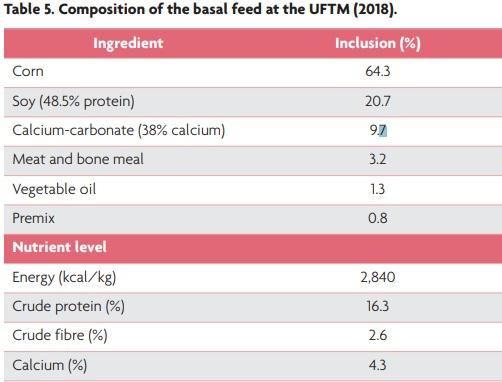
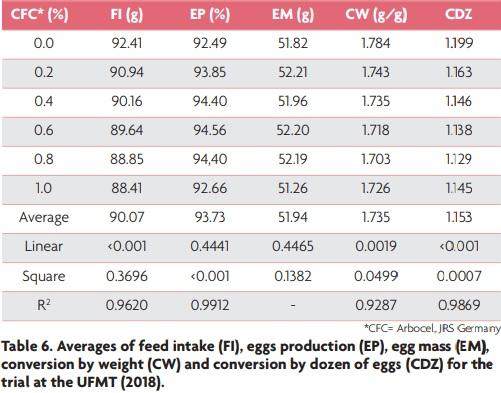
Yokhana et al. (2014) observed a significantly increased activity of the enzymes that are involved in the protein digestion in layer pullets due to the inclusion of 1.5% insoluble CFC. The results are shown in Table 7.
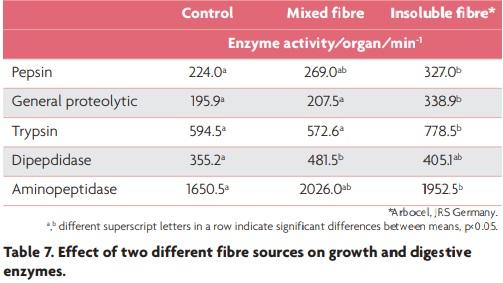
They also trialled a crude fibre concentrate that contained significant amounts of bark. This version was far less efficient.
Similar results concerning the activity of proteolytic enzymes have been observed by Boguslawska (2005).
These results additionally help to explain the improved protein digestion when using insoluble CFC.
Indeed Farran and his group evaluated the effect of insoluble CFC on the protein digestibility in two week old broilers.
They observed an improved protein digestion by 5.5% as shown in Table 8.

Summary and conclusion
The importance of fibre in layer feed formulation has been recognised amongst specialists. The nature of the supplemented fibre is very important. Fibre can be classified into insoluble and soluble fibre.
University and farm trials show that the insoluble fibre is a far better fibre source compared to soluble fibre. Traditional fibre sources also deliver soluble fibres and are often highly contaminated with mycotoxins and they deliver a low fibre content. The crude fibre concentrates based on lignocellulose are insoluble, high in fibre and free of mycotoxins. It was demonstrated that crude fibre concentrates have a positive impact on the performance of layers in terms of laying performance.
In a recent university trial it was demonstrated that the crude fibre concentrates cause a reduction of feed intake most probably due to their positive impact on digestion.
This article was originally published in International Poultry Production • Volume 27 Number 6.
Related topics
Authors:
JRS - J.Rettenmaier & Söhne
Influencers who recommended :
Ghorbanali Sadeghi, Dr. Manfred PietschRecommend
Comment
Share
Recommend
Reply
Recommend
Reply
Recommend
Reply

Would you like to discuss another topic? Create a new post to engage with experts in the community.







.jpg&w=3840&q=75)